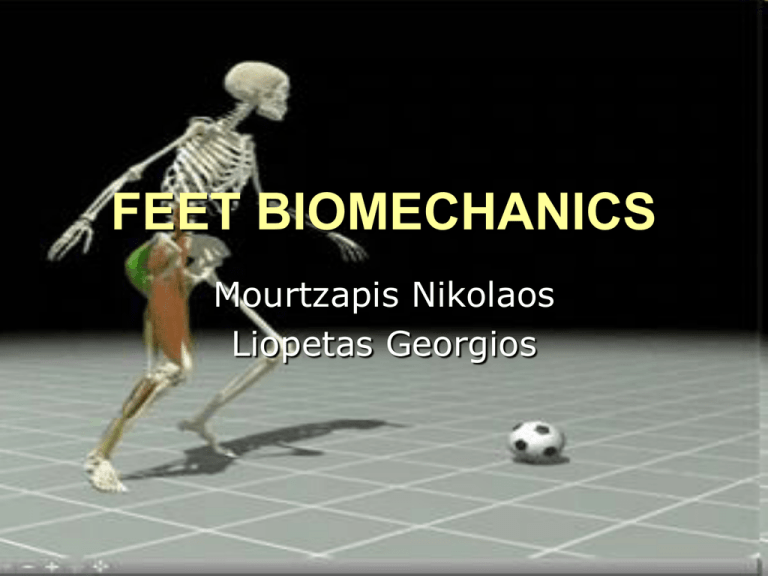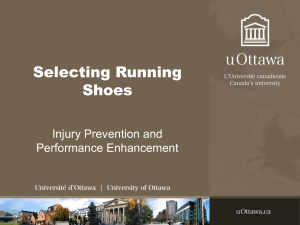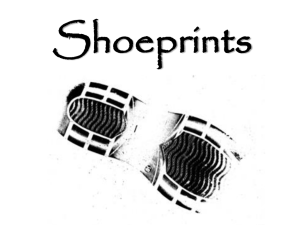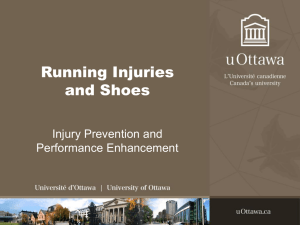BIOMECHANICS
advertisement

FEET BIOMECHANICS Mourtzapis Nikolaos Liopetas Georgios What does it mean ? Biomechanics is the application of mechanical principles to living organisms. This includes bioengineering: – the research and analysis of the mechanics of living organisms – the application of engineering principles such as thermodynamics, continuum mechanics, and mechanical engineering to and from biological systems. Sports Biomechanics we apply the laws of mechanics and physics to human performance in order to gain a greater understanding of performance in athletic events through: – modeling, – computer simulation – measurement. common methods used in sports biomechanics Elements of Mechanical Engineering Electrical Engineering Physics/Dynamics Computer Science Clinical Neurophysiology biomaterials They are of crucial importance to biomechanics because skin, bones, and arteries have unique material properties. The passive mechanical response of the tissues can be attributed to its biological characteristics. Why sport biomechanics are important? Applied loads and deformations can affect the properties of living tissue. There is much research in the field of growth and remodeling as a response to applied loads. Living tissue is remodelled as a direct consequence of applied loads. – For example bone growth in response to exercise Running shoes and the Biomechanics of your feet Running shoes are continually evolving – each model of shoe within each brand is built for specific foot types! There is no "perfect" or "best" shoe on the market. Everyone's feet are different in shape and function differently. How to choose the right running shoes? you need to know how your feet work. – – Knowing the biomechanics of your feet will help you better understand what type of running shoe is right for you. A visit to your local podiatrist is a great start for a complete foot evaluation. At the store: An experienced salesman who has been fitting shoes for years can help you. What are your running plans? Tell the podiatrist or salesman of your running plans. – Do you want to complete a marathon? – Would you like to maintain a weekly running base? Offer as much information as you can about your running. This will truly help you obtain the right pair of shoes to meet your goal! Feet Evaluation key points 1. 2. 3. 4. 5. 6. Is the arch for each foot flat, normal or high? Are there additional biomechanical concerns based on my foot type? If so, what are they and the effect toward running? Is there a need to wear orthotics with my shoes? What type of shoe will best suit your foot type - neutral, stability, motion control? What is the correct size of my feet (this includes length and width)? types of running shoes Below is a listing of shoe types and basic foot types: – Neutral: Underpronator/biomechani cally efficient – Stability: Mild to moderate pronation – Motion Control: Moderate to severe overpronator/heavier weight runners – Light Weight Racer: Biomechanically efficient runner or race day shoe Orthotics affect the shoe type you need! How to shop running shoes? Purchase your shoes at a local running store where you are professionally fitted for shoes. Shop later in the day when typically your foot is most swollen. Picking a shoe off the wall in a large sporting good store is not recommended . If you consider the amount of pressure created with each foot strike, how could you not have your feet fitted by a specialist who knows the running shoes available on the market? Remember, you only have two feet - for your life! During your visit to the running store Ask the following questions to the salesmen: How long have they worked at the store? What is their running background? What is the best shoe? The best shoe is one that is the correct category of shoe and the pair that feels the best on your feet. Ask yourself: Was the salesmen answering your questions? Did they check the measurement of your feet both width and length? (Did you receive the same sizing as from your foot evaluation?) What is the store return policy for running shoes? During your visit to the running store Try on all of the brands in the store in the model that is appropriate for your foot type. – Walk around the store, run on the store treadmill – Take Your Time – If your budget allows, consider purchasing two pairs of shoes to alternate. How long will my new running shoes last? They typically last from 300 to 500 miles or approximately 6 months. Check /evaluate your shoes at the running store to determine how much life is left in your running shoes. If you begin to develop foot pain or pain in the shin area, consider replacing your shoes. if the pain continues more than 5 -7 days, see the Podiatrist. Once you have purchased your shoes… To keep track of the life of the shoe, discreetly write the date on the outside heel area. – The date helps you keep track of the length of time for the shoes. Remember 500 miles or 6 months; whichever comes first! Consider donating your worn out shoes to charity or be green and recycle them!










